The 207th Street Train Yard Facility stands as a unique and historically significant location within the New York City Transit Authority (NYCTA) system. Nestled in Inwood, Manhattan, along the Harlem River, this facility holds the distinction of being the sole New York City subway yard equipped with a float bridge. This feature allowed for the direct transfer of subway cars and equipment via car floats, connecting the yard to the broader rail network of New York Harbor. This article delves into the rich history of the 207th Street Yard, its strategic importance, and the distinctive float bridge that set it apart.
Delving into the History and Property of the 207th Street Yard
The story of the 207th Street Yard begins in the early 1920s, fueled by Mayor John Hylan’s vision for a municipally owned and operated rapid transit system. This ambitious plan aimed to challenge the dominance of the privately-owned Brooklyn Manhattan Transit (BMT) and Interborough Rapid Transit (IRT) lines. In 1921, Governor Nathan Miller established the Transit Commission, paving the way for the Independent Subway System (IND). The IND’s Eighth Avenue Line, crucial to this narrative, commenced construction on April 3, 1925.
The 207th Street Yard, constructed between 1925 and 1930, was conceived as a vital storage and maintenance hub for the burgeoning Eighth Avenue Subway line. Located in northern Manhattan, it is bordered by Tenth Avenue to the west, the Harlem River to the east, West 215th Street to the north, and West 207th Street to the south. This expansive yard, still active today under the Metropolitan Transportation Authority (MTA), encompasses approximately 16 city blocks, totaling about 36.54 acres.
 Historic 1930 Map of 207th Street Yard Area
Historic 1930 Map of 207th Street Yard Area
Service on the Eighth Avenue Line commenced on September 10, 1932, stretching from 207th Street down to the Hudson Terminal. The Hudson Terminal, a significant transportation hub of its time, was later acquired by the Port Authority to make way for the World Trade Center.
Over time, the New York City subway system underwent unification. In 1940, the IND, BMT, and IRT divisions were consolidated under the Board of Transportation, which later became the New York City Transit Authority in 1953. In 1968, the NYCTA was integrated into the Metropolitan Transportation Authority (MTA). Despite these organizational shifts, the legacy of the original divisions persisted, with the IRT becoming the ‘A’ Division and the BMT/IND lines forming the ‘B’ Division. This distinction remains relevant due to the different dimensions of IRT lines, which are incompatible with ‘B’ Division cars.
Today, the 207th Street Yard, also known as the “207th Street Overhaul Shop” within the MTA, continues to play a critical role. It serves as a storage facility for subway trains during off-peak hours and a maintenance, overhaul, and repair center for subway cars. Furthermore, it is used for preparing vintage equipment for display at the Transit Museum. Although originally built for the IND Eighth Avenue Line, it now services both ‘A’ and ‘B’ divisions, providing access to the entire subway network. While the yard remains active, the float bridge and its associated overhead gantry were removed sometime after 1980.
The Unique Float Bridge and its Trackage at 207th Street Yard
Information regarding the float bridge at the 207th Street Yard, a defining feature of this facility, is relatively scarce despite the wealth of historical data on the Independent Lines. It’s important to note the “private” nature of the 207th Street float bridge. Unlike the trunk line railroads in New York Harbor with extensive float bridge networks for general freight, the 207th Street and Procter & Gamble Port Ivory float bridges were primarily dedicated to their respective operations, handling traffic directly related to their businesses.
Historical research suggests that marine deliveries to the 207th Street Yard were typically handled by tugs from the railroad that loaded the carfloat. The transit system would have needed to hire tugs specifically for outbound shipments, such as cars being sent for rebuilding.
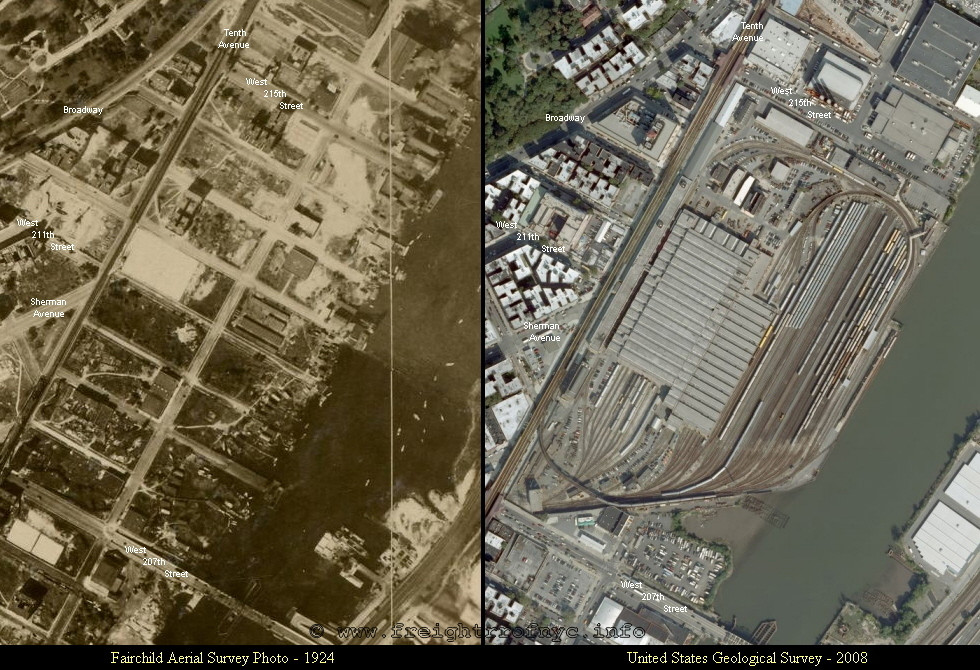 Aerial View of 207th Street Yard Area in 1924 and 2008
Aerial View of 207th Street Yard Area in 1924 and 2008
An examination of a 1924 Fairchild Aerial Survey Photo reveals the area prior to the yard’s construction, showing waterfront industries and tidal marshes. By contrast, a 2008 aerial image clearly shows the developed yard. Given the commencement of Eighth Avenue Line construction in 1925, it’s plausible that the float bridge was installed around this time, with evidence confirming its existence by 1930 for the arrival of the first R1 subway cars. However, the precise installation year remains undetermined.
Trackage within the 207th Street facility is extensive, as expected for a major subway yard. Of particular interest regarding the float bridge are the two tracks that ran along the Harlem River bulkhead. These tracks served as the float bridge leads, with the float bridge itself positioned at their northern end. The bridge was of a pony plate girder design with an overhead counterbalance structure.
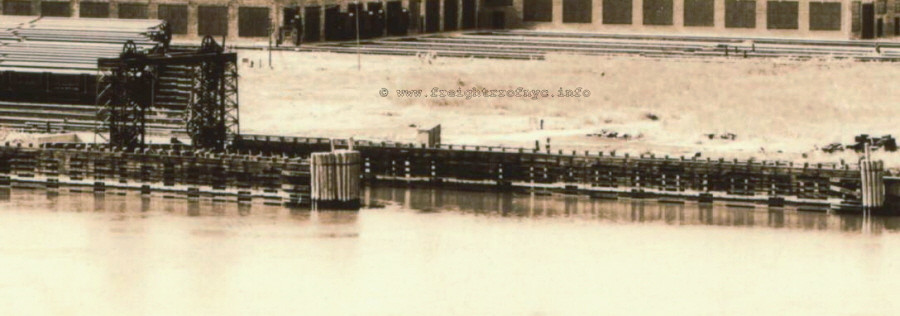 1931 View of 207th Street Yard and Float Bridge
1931 View of 207th Street Yard and Float Bridge
 1931 View of 207th Street Yard and Float Bridge
1931 View of 207th Street Yard and Float Bridge
Historical records indicate that while the float bridge was in place by February 24, 1930, it wasn’t initially connected to the yard trackage. Subway car deliveries were intended to utilize this bridge, although bulk deliveries of coal and sand were primarily handled by barge.
 Early Image of the 207th Street Yard Float Bridge
Early Image of the 207th Street Yard Float Bridge
 1931 Image of Whitcomb Locomotive and Bush Terminal Carfloat at 207th Street Yard
1931 Image of Whitcomb Locomotive and Bush Terminal Carfloat at 207th Street Yard
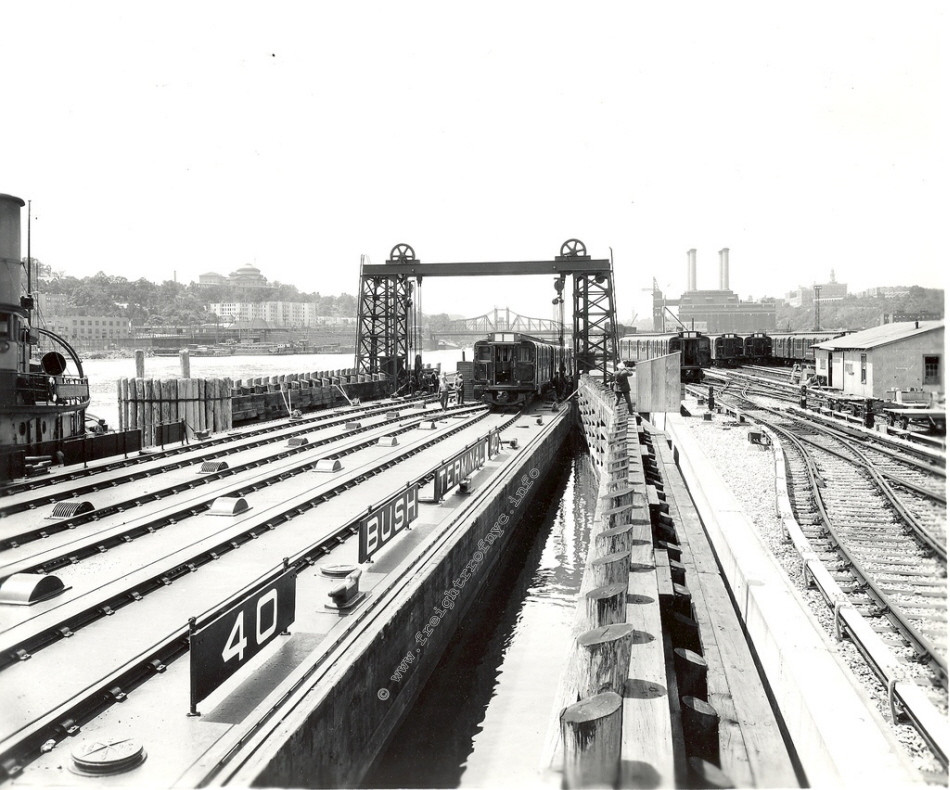 Bush Terminal Carfloat at 207th Street Yard in 1931
Bush Terminal Carfloat at 207th Street Yard in 1931
The 207th Street float bridge was noted for its shorter length, approximately 70 feet, compared to the more common 90 to 100-foot bridges used by other railroads in the New York area. The reason for this shorter design remains unknown. This float bridge facilitated the crucial transportation of subway cars, both new deliveries and obsolete cars being removed from service. Its significance lies in its status as the only such facility within the entire New York City subway system.
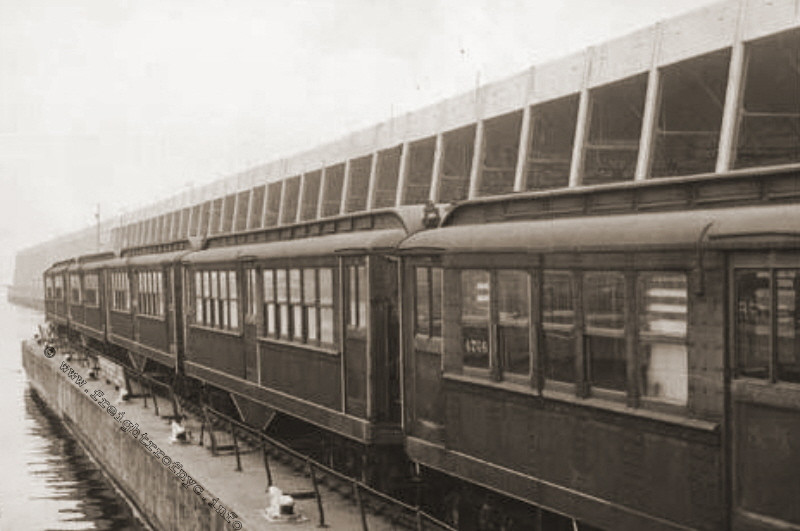 1950 Image of Subway Cars on a Carfloat at Bush Terminal
1950 Image of Subway Cars on a Carfloat at Bush Terminal
While an image from Bush Terminal illustrates the general process of handling subway cars via carfloat, it’s important to note that in this particular instance, the cars were likely destined for the IRT shops in the Bronx, not the 207th Street Yard, as IRT cars were not typically serviced at IND facilities.
A 1965 track map of the 207th Street Yard marks the float bridge as abandoned, though aerial photos suggest it remained in place, albeit without track connections, until around 1980.
 1965 Track Map of 207th Street Yard Showing Float Bridge
1965 Track Map of 207th Street Yard Showing Float Bridge
The design of the 207th Street float bridge was also unique, differing from the standard designs used in New York Harbor. Anecdotal evidence suggests that several new R-62 subway cars were lost when a carfloat capsized at this location due to improper loading, potentially indicating design flaws in the bridge, particularly for handling subway cars. This incident, if confirmed, would suggest the float bridge was reactivated for deliveries of R62 cars, which occurred between 1983 and 1987.
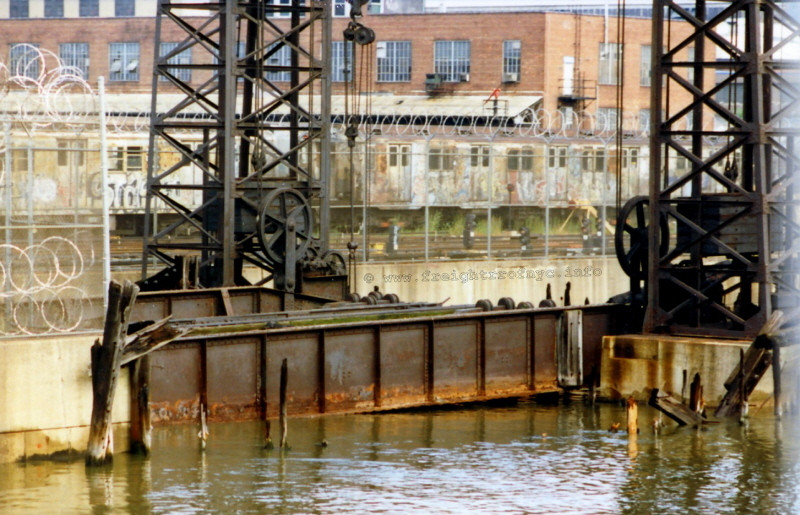 Close-up of 207th Street Yard Float Bridge Structure
Close-up of 207th Street Yard Float Bridge Structure
Observations of the float bridge’s structure reveal an unusual design where the bulkhead anchor end appears to be partially submerged, raising questions about potential design flaws or structural issues.
 Aerial View of 207th Street Yard in 2008
Aerial View of 207th Street Yard in 2008
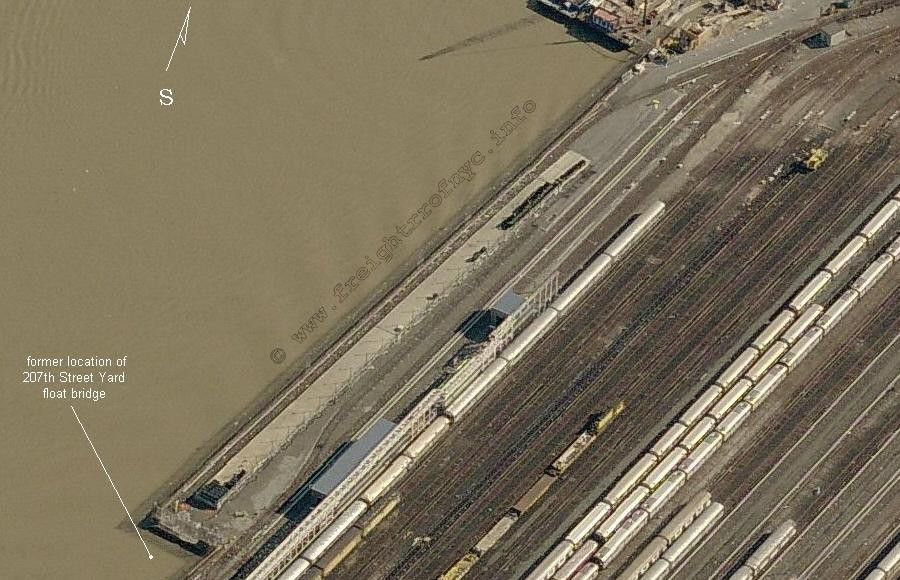 Oblique Aerial View of 207th Street Yard Bulkhead in 2008
Oblique Aerial View of 207th Street Yard Bulkhead in 2008
Current aerial views from 2008 depict the yard’s layout after the float bridge’s removal, showcasing its present configuration.
Locomotives of the 207th Street Yard Float Bridge
Two locomotives are specifically documented as being used at the 207th Street Yard for float bridge operations. While any IND or NYCTA locomotive could theoretically perform this task, photographic evidence suggests dedicated locomotives were assigned to the float bridge.
The first documented locomotive was a Whitcomb 30 Ton Gas Mechanical (30T GM6) built in 1930. This locomotive, lacking a visible road number in photographs, was used in the early operations of the yard.
 Whitcomb Locomotive at 207th Street Yard in 1930
Whitcomb Locomotive at 207th Street Yard in 1930
 Whitcomb Locomotive at 207th Street Yard in 1930
Whitcomb Locomotive at 207th Street Yard in 1930
After its service with the IND, this Whitcomb locomotive was sold through a dealer and subsequently used by construction firms and refineries. Remarkably, it survives today at the Great Plains Transportation Museum in Wichita, KS.
 Whitcomb Locomotive at Great Plains Transportation Museum
Whitcomb Locomotive at Great Plains Transportation Museum
The second type of locomotive used was an electric “drill motor,” powered by the third rail. Two drill motors, numbered 41 and 42, were built by Magor Car Builders in 1930 for the 207th St. Shop. These units were equipped with cable reels to draw power off the third rail, allowing them to operate beyond the electrified tracks within the yard. Initially designed for shop work, their cable reels were removed in 1948, and they were reassigned to yard switching duties, including assembling refuse trains.
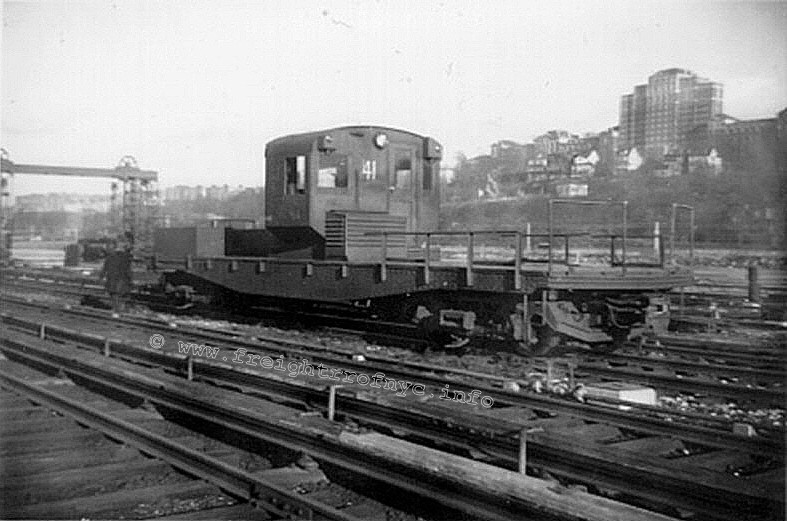 Drill Motor #41 at 207th Street Yard Float Bridge in 1947
Drill Motor #41 at 207th Street Yard Float Bridge in 1947
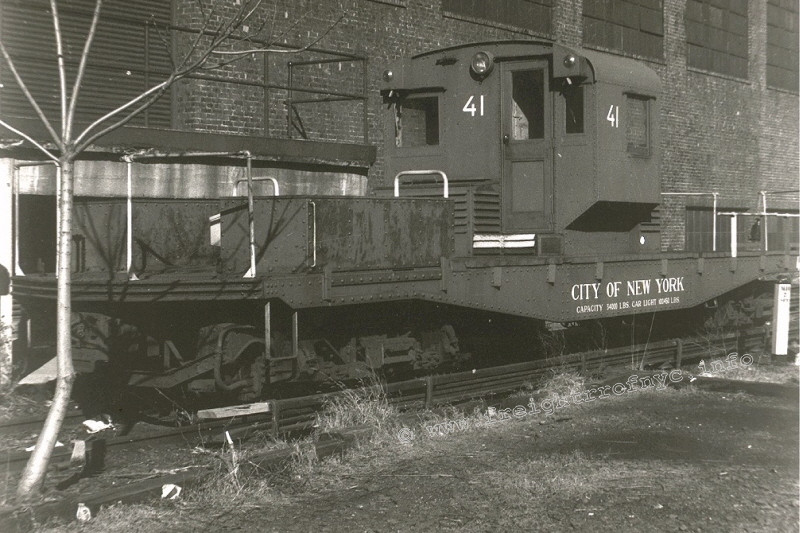 Drill Motor #41 at 207th Street Yard
Drill Motor #41 at 207th Street Yard
Drill motor #41 was renumbered 20010 in 1962 but retained its original number as well.
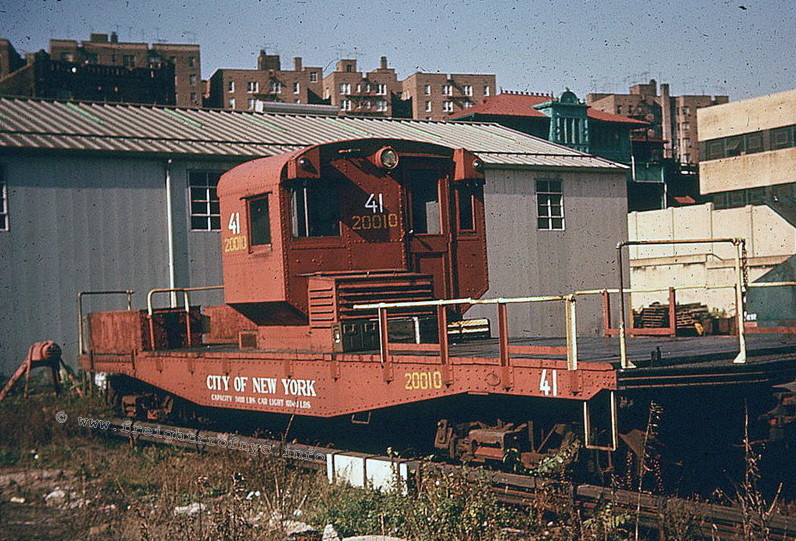 Drill Motor #41/20010 at 207th Street Yard in 1962
Drill Motor #41/20010 at 207th Street Yard in 1962
In 1978, #41 was sold to the Trolley Museum of New York (TMNY). Although initially on loan to the Transit Museum and later under the care of the Railway Preservation Corp., #41 was eventually transported to the Trolley Museum of New York in Kingston, NY, in 2021.
 Drill Motor #41/20010 at Coney Island Shops
Drill Motor #41/20010 at Coney Island Shops
207th Street Yard Locomotive Roster
| Number / Name | Builder | C/N | Build Date | Gauge | Wheel Arrangement | Model | Wheel Dia | Acquired | Disposition | Notes | Ref |
|---|---|---|---|---|---|---|---|---|---|---|---|
| Whitcomb | 13046 | 1930 | Std. | C | 30 Ton GM6 | New | Sold to Utah Construction, then Texaco, then Socony Vacuum/Mobil Oil, now at Great Plains Transportation Museum | [a] | [16] | ||
| 41 / 20010 | Magor | 1932 | Std. | B-B | New | Renumbered 20010, sold to Trolley Museum of New York, then Railway Preservation Corp., returned to Trolley Museum of New York | [b] [c] | [45] |
Locomotive Footnotes
| [a] | Whitcomb builder records are inconclusive, but North East Rails website indicates similar locomotive used at NYC “IRT” subway. Sales history: NYC Subway, RC Stanhope, Utah Construction/Morrison-Knudsen, Texas Co. (Texaco), Socony Vacuum Co., Mobil Oil, Great Plains Transportation Museum. |
|—|
| [b] | Remained at Coney Island Shops until 2021, then transported to Kingston, NY. |
| [c] | Stored at NYCTA Coney Island Shops & Yard. |
Conclusion: The Enduring Legacy of the 207th Street Yard
The 207th Street Train Yard Facility, with its unique float bridge, represents a fascinating chapter in the history of the New York City subway system. As the only subway yard with this marine connection, it played a vital role in the delivery and removal of subway cars, showcasing an innovative approach to urban transportation logistics. While the float bridge is no longer extant, the 207th Street Yard continues to serve as a critical maintenance and storage hub, a testament to its enduring importance within the MTA network. Its story highlights the ingenuity and complexity of developing and maintaining a vast urban transit system like the New York City Subway.
